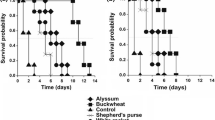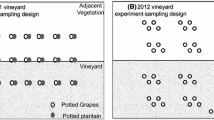Abstract
The sunflower stem weevil, Cylindrocopturus adspersus (LeConte) (Coleoptera:Curculionidae), is apest of cultivated sunflower (Helianthusannuus L) from the southern to the northernGreat Plains. The incidence of weevilinfestation in fields from the six differentstates sampled during 1996 and 1997 ranged from33% (Minnesota) to 100% (Kansas, Colorado,Nebraska). Weevil populations in the fieldssampled were statistically greater in thecentral Plains (Colorado, Kansas, Nebraska)with a mean of 12.3 and 19.5 larvae per stalkcompared with the northern Plains (North andSouth Dakota, Minnesota) of 0.7 and 1.3 larvaeper stalk in 1996 and 1997, respectively.Parasitization of weevils varied from field tofield ranging from 1 to 100%, but was usuallyless than 20%. The nine species oflarval parasitoids recovered were allHymenoptera and included: Nealioluscurculionis (Fitch), N. collaris(Brues), Bracon sp. (Braconidae); Neocatolaccus tylodermae (Ashmead), Chlorocytus sp., Pteromalus sp.(Pteromalidae); Quadrastichus ainslieiGahan (Eulophidae), Eurytoma tylodermatisAshmead (Eurytomidae); and Eupelmus sp.(Eupelmidae). Nealiolus curculionis wasthe most prevalent parasitoid reared from C. adspersus, and it was recovered from allstates sampled. Parasitoid species richness wasgreatest in the central Plains. Thereduced number of parasitoid species foundattacking C. adspersus in the northernPlains may be caused by low host populationlevels, slow migration by parasitoids into theregion, or lack of adaptation to climaticconditions. Additional work to understandthe population dynamics of the parasitoidcomplex associated with C. adspersus mayresult in improved biological control of thesunflower stem weevil in cultivatedsunflower.
Similar content being viewed by others
References
Armstrong, J.S., 1996. Development of a degree-day based prediction model for adult sunflower stem weevil, Cylindrocopturus adspersus, emergence. In: Proceedings 18th Sunflower Research Workshop, Natl. Sunflower Assoc., Fargo, ND, 11–12 January 1996. National Sunflower Assoc., Bismarck, ND. pp. 49–51.
Armstrong, J.S., 1997. New host records for Cosmobaris americana Casey (Coleoptera: Curculionidae) and its parasite, Neocatolaccus tylodermae Ashmead (Hymenoptera: Pteromalidae). J. Kansas Entomol. Soc. 70: 258–260.
Arthur, A.P. and P.G. Mason, 1990. Distribution and abundance of the sunflower stem weevil, Cylindrocopturus adspersus (LeConte) (Coleoptera: Curculionidae), in Saskatchewan. Can. Entomol. 112: 387–388.
Beacher, J.H., 1947. Studies of pistol case-bearer parasites. Ann. Entomol. Soc. Am. 40: 530–544.
Bugbee, R.E., 1967. Revision of chalcid wasps of genus Eurytoma in America north of Mexico. Proc. U.S. Nat. Mus. 118: 433–552.
Casals-Bustos, P., 1976. Bionomics of Cylindrocopturus adspersus LeC. and Baris strenua (LeC.) (Coleoptera: Curculionidae). Ph.D. diss., North Dakota State University, Fargo. p. 108.
Charlet, L.D., 1983a. Distribution and abundance of a stem weevil, Cylindrocopturus adspersus (Coleoptera: Curculionidae), on cultivated sunflower in the northern plains. Environ. Entomol. 12(5): 1526–1528.
Charlet, L.D., 1983b. Insect stem fauna of native sunflower species in western North Dakota. Environ. Entomol. 12: 1286–1288.
Charlet, L.D., 1983c. Parasitoids of a stem weevil, Cylindrocopturus adspersus, in sunflower: incidence and parasitization rates in the northern Great Plains. Environ. Entomol. 12: 888–890.
Charlet, L.D., 1987. Seasonal dynamics of the sunflower stem weevil, Cylindrocopturus adspersus (LeConte) (Coleoptera: Curculionidae), on cultivated sunflower in the northern Great Plains. Can. Entomol. 119: 1131–1137.
Charlet, L.D., 1994. Seasonal abundance and impact of the sunflower stem weevil parasitoid, Nealiolus curculionis (Hymenoptera: Braconidae) in the northern Great Plains. Biol. Control. 4: 26–31.
Charlet, L.D., 1999. Biological control of sunflower pests: searching for new parasitoids in native Helianthus — challenges, constraints, and potential. In: L.D. Charlet and G.J. Brewer (eds), Biological Control of Native or Indigenous Insect Pests: Challenges, Constraints, and Potential, Thomas Say Publications in Entomology, Entomol. Soc. Am., Lanham, MD. pp. 91–112.
Charlet, L.D. and E.U. Balsbaugh, Jr., 1984. Anaphes conotracheli (Hymenoptera: Mymaridae), an egg parasitoid of Cylindrocopturus adspersus (Coleoptera: Curculionidae). J. Kansas Entomol. Soc. 57: 526–528.
Charlet, L.D. and G.J. Seiler, 1994. Sunflower seed weevils (Coleoptera: Curculionidae) and their parasitoids from native sunflowers (Helianthus) in the northern Great Plains. Ann. Entomol. Soc. Am. 87: 831–835.
Charlet, L.D. and T.J. Gulya, Jr., 1984. Stem weevil: biology and interaction with premature ripening. In: Proceeings Sunflower Research Workshop, Bismarck, ND, 1 February 1984, National Sunflower Assoc., Bismarck, ND. pp. 18–19.
Charlet, L.D., C.Y. Oseto and T.J. Gulya, 1985. Application of systemic insecticides at planting: effects on sunflower stem weevil (Coleoptera: Curculionidae) larvae numbers, plant lodging, and seed yield in North Dakota. J. Econ. Entomol. 78: 1347–1349.
Charlet, L.D., G.J. Brewer and B. Franzmann, 1997. Insect pests. In: A.A. Schneiter (ed), Sunflower Technology and Production. Agron. Ser. 35. Am. Soc. Agron., Madison, WI. pp. 183–261.
Charlet, L.D., G.J. Brewer and V.H. Beregovoy, 1992. Insect fauna of the heads and stems of native sunflower (Asterales: Asteraceae) in eastern North Dakota. Environ. Entomol. 21: 493–500.
Goeden, R.D. and D.W. Ricker, 1970. Parasitization of introduced puncturevine weevils by indigenous Chalcidoidea in southern California. J. Econ. Entomol. 63: 827–831.
Goeden, R.D. and D.W. Ricker, 1975. The phytophagous insect fauna of the ragweed, Ambrosia confertiflora, in southern California. Environ. Entomol. 4: 301–306.
Goeden, R.D. and D.W. Ricker, 1976. The phytophagous insect fauna of the ragweed, Ambrosia psilostachya, in southern California. Environ. Entomol. 5: 1169–1177.
Hawkins, B.A., 1994. Pattern & Process in Host-Parasitoid Interactions. Cambridge University Press, Cambridge, UK.
Krombein, K.V., P.D. Hurd, Jr., D.R. Smith and B.D. Burks, 1979. Catalog of Hymenoptera in America North of Mexico. I. Smithsonian Institution Press, Washington, DC. p. 1198.
Mitchell, J.D. and W.D. Pierce, 1911. The weevils of Victoria County, Texas. Proc. Entomol. Soc. Wash. 13: 45–62.
Müller, C.B., I.C.T. Adriaanse, R. Belshaw and H.C.J. Godfray, 1999. The structure of an aphid-parasitoid community. J. Anim. Ecol. 68: 346–370.
Newton, J.H., 1921. A sunflower pest. 12th Ann. Rept. Sta. Entomol. Colo. Circ. 35: 37–38.
Pierce, W.D., 1916. Notes on the habits of weevils. Proc. Entomol. Soc. Wash. 18: 6–10.
Pschorn-Walcher, H., 1977. Biological control of forest pests. Annu. Rev. Entomol. 22: 1–22.
Rogers, C.E., 1980. Natural enemies of insect pests of sunflower: a world view. Tex. Agric. Exp. Sta. Misc. Publ. 1457. Texas A & M University, College Station. p. 30.
Rogers, C.E. and J.G. Serda, 1982. Cylindrocopturus adspersus in sunflower: overwintering and emergence patterns on the Texas high plains. Environ. Entomol. 11: 154–156.
Rogers, C.E. and O.R. Jones, 1979. Effects of planting date and soil water on infestation of sunflower by larvae of Cylindrocopturus adspersus. J. Econ. Entomol. 72: 529–531.
SAS Institute, 1990. SAS/STAT User's Guide, Version 6, 4th ed., Volumes 1 & 2. SAS Institute, Cary, NC.
Schulz, J.T., 1978. Insect pests, pp. 169–223. In: J.E. Carter (ed), Sunflower Science and Technology. Agron. Ser. 19. Am. Soc. Agron., Madison, Wis. p. 505.
Seiler, G.J. and L.H. Rieseberg, 1997. Systematics, origin, and germplasm resources of the wild and domesticated sunflower. In: A.A. Schneiter (ed), Sunflower Technology and Production. Agron. Ser. 35. Am. Soc. Agron., Madison, WI. pp. 21–65.
Author information
Authors and Affiliations
Rights and permissions
About this article
Cite this article
Charlet, L., Armstrong, J. & Hein, G. Sunflower stem weevil and its larval parasitoids in the Central and Northern Plains of the USA. BioControl 47, 513–523 (2002). https://doi.org/10.1023/A:1016567930895
Issue Date:
DOI: https://doi.org/10.1023/A:1016567930895




